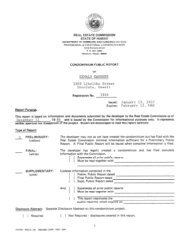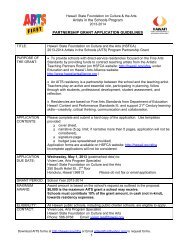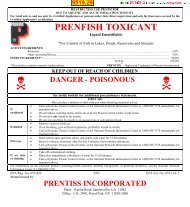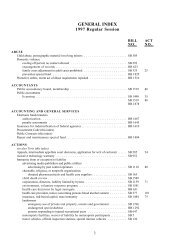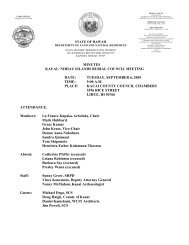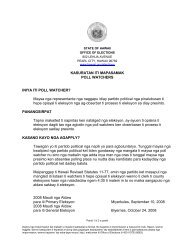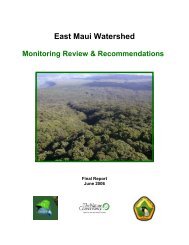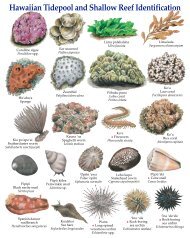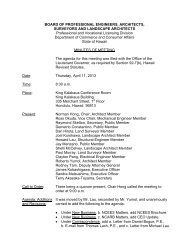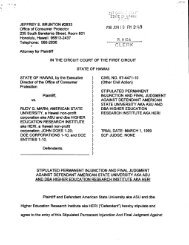Stream macroalgae of Hawai`i: an identification guide - Hawaii.gov
Stream macroalgae of Hawai`i: an identification guide - Hawaii.gov
Stream macroalgae of Hawai`i: an identification guide - Hawaii.gov
You also want an ePaper? Increase the reach of your titles
YUMPU automatically turns print PDFs into web optimized ePapers that Google loves.
Key to the common genera <strong>of</strong> <strong>Hawaii</strong><strong>an</strong><br />
stream <strong>macroalgae</strong><br />
1.a. Large alga (several to m<strong>an</strong>y centimeters in<br />
length) with a pl<strong>an</strong>t body differentiated into a stemlike<br />
axis with whorls <strong>of</strong> br<strong>an</strong>ches, not surrounded<br />
by mucilage – Chara (p.28)<br />
1.b. Org<strong>an</strong>ism either microscopic or macroscopic at<br />
the individual level, but cellular structures not<br />
evident without microscopic examination - 2<br />
2.a. Alga siphonous, as seen at the microscopic<br />
level (lacking cellular cross walls), or in some other<br />
form (e.g. needle-shaped colonies) - 3<br />
2.b. Alga filamentous when observed at the light<br />
microscopic level (includes crustose algae composed<br />
<strong>of</strong> filaments) - 4<br />
3.a. Alga a felty green mass <strong>of</strong> filaments, coarse to<br />
the touch, cells a yellowish-green color when<br />
observed under the light microscope, lacking cross<br />
walls - Vaucheria (p.44)<br />
3.b. Alga forming small star-shaped clusters <strong>of</strong><br />
needle-like cells, usually growing on larger algae or<br />
mosses, chloroplasts a golden color - Synedra (p.48)<br />
4.a. Filaments br<strong>an</strong>ched when observed<br />
macroscopically or using the light microscope, or<br />
4<br />
main axis composed <strong>of</strong> multiple filaments<br />
(multiseriate) - 5<br />
4.b. Filaments unbr<strong>an</strong>ched, or only very<br />
occasionally br<strong>an</strong>ched when observed<br />
macroscopically or using the light microscope,<br />
main axis composed <strong>of</strong> only a single filament<br />
(uniseriate) - 18<br />
5.a. Cell contents blue-green, olive-green or<br />
pinkish in color, lacking a nucleus <strong>an</strong>d<br />
chloroplast - 6<br />
5.b. Cell contents colored grass-green, yellowgreen,<br />
or as in 5a, but containing at least one<br />
nucleus <strong>an</strong>d chloroplast - 11<br />
6.a. Main axis <strong>of</strong> the alga (when viewed<br />
microscopically) composed <strong>of</strong> multiple filaments <strong>of</strong><br />
cells, alga appears cartilaginous <strong>an</strong>d is <strong>of</strong>ten<br />
pigmented a yellowish-brown color - Stigonema<br />
(p.24)<br />
6.b. Main axis <strong>of</strong> the alga composed <strong>of</strong> only a<br />
single filament (uniseriate) - 7<br />
7.a. Algal filaments uniform in diameter along<br />
their length or composed <strong>of</strong> bead-like cells - 8<br />
7.b. Algal filaments gradually tapering in diameter<br />
along their length - Dichothrix (p.14)




